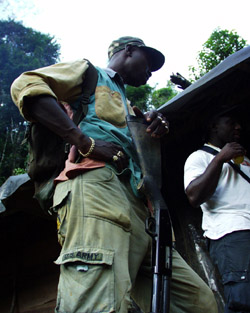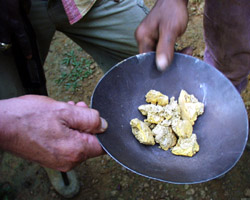| A Mine of Information
In diary entry 11 we
spoke to Mr Moniz from the CELOS Bio-prospecting project. He has a vision
for this small country. He thought that if only the Trio Shaman of Kwamalasamutu
would divulge their secrets and a cure was found for cancer or AIDS
then the whole country could become wealthy as a result. It was a nice
idea... but one that does not relate to the real world. Suriname is
a poor country surrounded by other poor countries. Hyperinflation, poverty,
health problems and all the familiar problems that affect 'underdeveloped'
countries are present here. You may wonder why I am beginning my diary
with this background information. We are in mining country... and gold
mining is a blight that has wreaked havock across the entire Amazonian
region leaving a trail of deforestation and mercury water pollution,
killing the rivers and ruining the health of the original inhabitants.
All this is known, and there is no need to re-work the familiar story
here. Mining is a reality and it is easy to sit back in Europe and America
and criticise poorer countries for destroying their environment. But
as Granman Gazon himelf said 'people have to eat, but there are good
and bad ways of going about things'. We could rant and rage about what
we have seen today but there is little point in doing that. It won't
change anything, and it does not move the debate forward. What we thought
we would try to do was to focus on ways that the impact of mining can
be controlled, ways to organise the social and environmental aspects
of the process so that the damaging effects can be minimised. Suriname
borders Brazil, and in recent years, driven by the need to find new
mining locations, Brazillian "Garimpieros" (small-scale miners) have
been flooding into Suriname and setting up operations here, At first
they were working for the Maroons who own the land. The Maroons themselves
have been mining for over a century but the Brazilian know-how helped
them work more productively and so there was a mutual benefit. More
recently the Garimpieros have been establishing their own unlicensed
and unregulated camps and defending them with shotguns. The Surinamese
government has neither the will or the resources to even begin to police
the situation. It needs all the income it can get and gold means money
- inflation-proof money.
The mining camps have a well established culture all of their own and
run on a strict set of rules. The 'boss' of the camp is the man who
owns the machinery. He gets 50% of the takings and the rest is split
between the team of five or six workers that he employs. In cases where
the boss is working on land that belongs to someone else it is a long
established rule that the land-owner gets 10% of the takings (leaving
the rest to be divvied up between the boss and the workers). The only
other people in the scenario are the storekeepers - savvy entrepreneurs
who sell supplies (especially beer) to the miners for measurements of
gold. Where we are here for example, a can of margarine goes for 4 grammes,
and a pack of chewing gum for 0.5 of a gramme. Apart from the storekeepers
there are the inevitable gaggle of prostitutes who also ply their trade
for raw gold. (I do not know the rate!).
So what can we possibly say that is positive about what we have seen
today? The area that we are in is part of a mining concession granted
to Henk Naarendorp, a self-made man and gold entrepreneur and our host
here in Antino. A few years ago he was a consultant to a big Canadian
mining company called 'Gold Star'. They have a none-too savoury reputation
as they were responsible for a large cyanide spill in Guyana a few years
back. To keep up appearances the Surinamese government, not wanting
to give the impression that vast tracts of the country were being handed
over to foreigners, stipulated a restriction on the size of concessions
that it would grant. So Golden Star thought of the idea of working through
third parties like Henk Naarendorp. At the time the country was just
recovering from the 'Interior War', a rumbling conflict that lies behind
so many of the conditions that wee see today in Suriname. Henk was keen
to attract foreign investment into the country and also saw Gold Star
as a way to make himself a fair bit of money too. Henk too took out
an exploration concession on this area, and funded by Gold Star, started
researching the feasibility of extracting gold from this area. After
initial results were quite positive and a small amount of infrastructure
had been established here, there was a slump in the gold-price and Gold
Star shelved their project in Henk’s concession. Henk moved in
and applied for an exploitation licence here, believing that there would
be money to be made owning the rights to a potentially productive area.
However he didn't have the capital backing of Gold Star so decided to
work it another way.
As I have said, Garimpieros will pay 10% to the owner of the land -
or the person who owns the right to exploit that land. In the end it
makes sense for them as (often illegal) immigrants, to ensure that they
are free from harassment from outside. (Vitally this gives the owner
of the land some leverage over the others).
Henk arrived this morning by plane and we took the opportunity to take
a flight over the area. We flew over Henk’s concession and over
neighbouring ones. There is no getting round the fact that all mining
devastates the land. Two motors are used in the process. The alluvial
gold deposits lie at the bottom of the gravely layer that sits on a
clay base. A section of forest is cleared of trees. One motor blasts
a powerful water-jet that cuts deep into the ground. Another motor sucks
up the liquified earth and passes it over a sluice-box, lined with 'astro-turf'
carpet which catches the heavy sediments (ie gold) in its fibres. After
a couple of weeks tonnes of earth have passed over the box and the carpets
are rinsed out and mercury (locally "Quick”) is added to the sandy
residue. This amalgamates the fine alluvial golden granules. It was
quite amazing today to see the end of the process and the gold appearing
from the mud and the sand at the bottom of the box.
In all mining trees are uprooted and the area is layed waste. While
Henk acknowledges that no mining is totally without damage he has put
in place a set of rules on his concession that all the garimpieros are
forced to follow. Gio, Henk’s foreman, spends his days riding
around the concession on his four wheeler motorbike ("All Terrain Vehicle"(ATV)
with a pistol in his holster and a shotgun on his lap. His job is not
only to collect Henk’s 10%, but also to ensure that some basic
principles are followed to minimise the environmental impact. No more
trees are felled than is strictly necessary. Mercury is used but only
in the final stages, then a 'retort' must be used to re-claim 95% of
the mercury from the gold when it is separated out at the final phase
of the process. Henk also stipulates that the mines should run into
each other... so that each hole that is gouged out of the earth is filled
in by the next one.
Now, I am aware that it may sound like I am letting our host Henk of
the hook. Today’s aerial shots don't lie and the environmental
impact is real. However there is order to the chaos here. Henk is also
putting in place a Malaria control programme which is desperately needed
in a area with the highest malarial mortality rate in the whole of South
America. His tight control of his land through Gio and his men also
reduces banditry and crime .... another serious problem. There are 200
garimpieros working here. It is only when you consider that an estimated
20,000 garimpieros are active in Suriname (mainly in the Marowinje and
Brownsberg areas) and they are largely working in a completely uncontrolled
and unregulated way that you begin to think again and wonder if working
with the garimpieros isn't the way forward. Henk is driven by profit
like any other entrepreneur. But he seems to have a sense of responsibility
in his work. It was gratifying to see the Mercury produced by the retort
with my own eyes at the end of this long day.
If anybody out there has any more information on mining and other possible
ways to minimise the damaging effects,or wants to take issue with our
representation of what we have seen today then we would welcome comments
in the discussion boards in the "Virtual Base Camp" section of our site.
One thing is for sure - the problem isn't going to disappear - the people
in this part of the world are real people with real needs and bellies
to fill just lie you and me.
On the flight with Henk we also flew in Karin Boven,an Anthropologist
who has worked extensively with the Wayana people. It is good that people
like her should meet Henk. Tomorrow we go to Kwemahakhan further upstream,
where we will look at the ways in which mining has effected this tribe
who now number only around 1000 souls. They are the people who bare
the brunt of the problem and tomorrow is a new day.
|

Birds Eye View

Blasting for Bullion

The Old Method

Gio - The Sheriff!

The Driving Force
|










